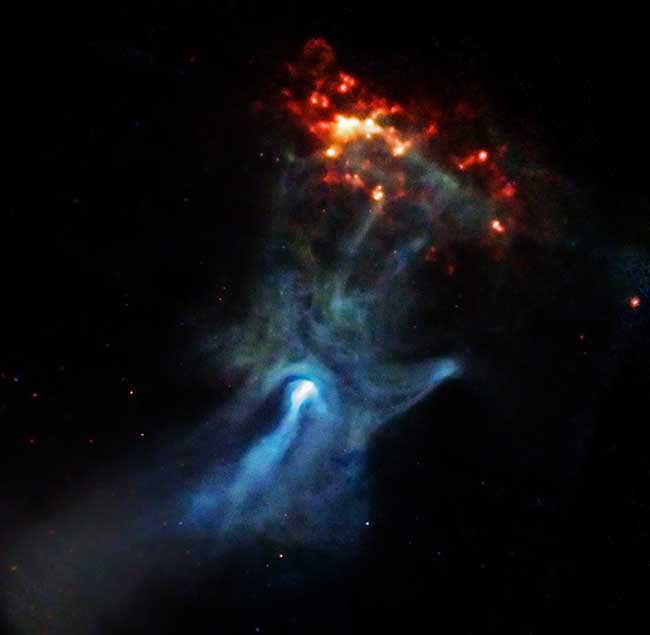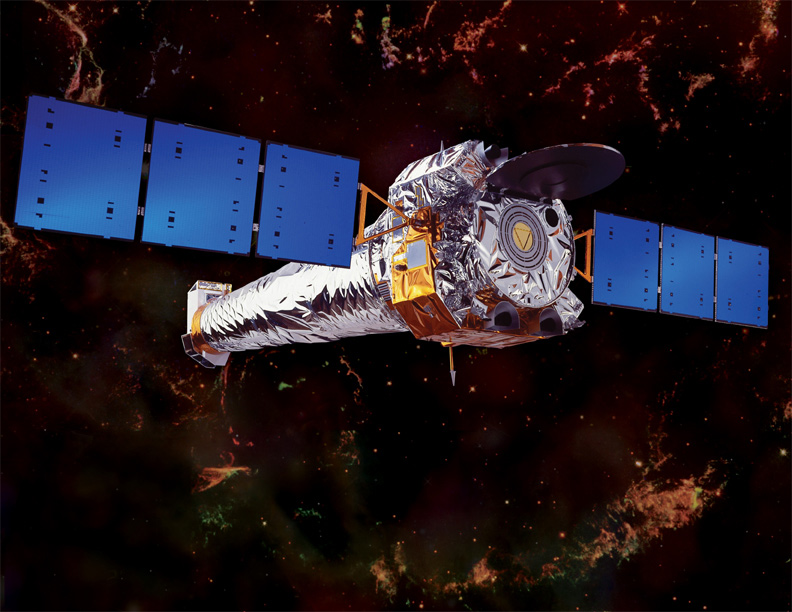Chandra X-Ray Observatory: Revealing the invisible universe

The Chandra X-Ray Observatory is a NASA telescope that looks at black holes, quasars, supernovas, and the like – all sources of high energy in the universe. It shows a side of the cosmos that is invisible to the human eye.
After more than a decade in service, the observatory has helped scientists glimpse the universe in action. It has watched galaxies collide, observed a black hole with cosmic hurricane winds, and glimpsed a supernova turning itself inside out after an explosion.
The telescope – billed as one of NASA's Great Observatories along with the Hubble Space Telescope, Spitzer Space Telescope and the Compton Gamma Ray Observatory – has been a public relations tool for the agency, as well. Its pictures are frequently used by NASA in press releases.
One of Chandra's more notable images is of what appears to be a cosmic "hand" reaching for a bright nebula, although the scientific explanation is quite different. [Gallery: Amazing Photos by NASA's Chandra X-Ray Observatory]
Developing Chandra
X-ray astronomy is especially challenging because you need to leave the Earth's atmosphere behind to observe the rays. The first X-ray observations were fleeting, taking place in minutes-long sounding rocket flights, or perhaps for a few hours in a stratospheric balloon.

In 1962, Italian-American astronomer Riccardo Giacconi and his team sent a rocket with an X-ray detector aloft, and discovered the first source of stellar X-rays. Giacconi was naturally eager to do more research.
Based on his design, NASA launched the first X-ray telescope: Uhuru, which was also known as the Small Astronomical Satellite-1. It remained in orbit for more than two years and discovered the first signs of a black hole. Another of his team's ideas – the Einstein Observatory – flew from 1978 to 1981. This was the first X-ray telescope that could take pictures.
Giacconi, now an established authority in X-ray astronomy, teamed up with the Smithsonian's Harvey Tananbaum to propose a more powerful observatory. Dubbed the Advanced X-ray Astrophysics Facility, its goal was to take "high-resolution images and spectra of X-ray sources," according to Harvard University.
The telescope was first proposed in 1976. Work proceeded in the 1980s, and the telescope was reconfigured in 1992 (by reducing mirrors and instruments) to save money and to make it suitable to launch by shuttle. Shortly before launch, the telescope was renamed "Chandra" after Nobel laureate and astrophysicist Subrahmanyan Chandrasekhar.
Chandra launched July 23, 1999, from the payload bay of space shuttle Columbia, the largest satellite the shuttle ever launched. Just eight hours after Columbia reached space, Chandra left the shuttle's shelter and rocketed away. Controllers made several adjustments to Chandra's orbit in the coming days.
When finalized, Chandra was in an elliptical orbit around Earth ranging anywhere from about 9,940 miles (16,000 kilometers) to 82,650 miles (133,000 kilometers) from Earth. At its zenith, Chandra is about a third as far as the distance from the Earth to the moon. This allows it to make observations for as long as 52 hours before losing sight of its target.
As for Giacconi, the long-standing champion of Chandra? He shared a Nobel Prize for his pioneering work in X-ray astronomy in 2002. His colleague, Tananbaum, became director of the Chandra X-ray Center in 1991, a position he still holds today.
Targets after first light
"First light," or the first time Chandra opened its telescopic eyes to space, took place in mid-August 1999. One of its first pictures was of Cassiopeia A, the remnants of a star that exploded in a supernova witnessed by Tycho Brahe in 1572.
The picture was pretty, but more importantly, Chandra was already probing into Cassiopeia A's history. "Scientists can see evidence of what may be a neutron star or black hole near the center," NASA wrote in an August 1999 press release.
Later that year, astronomers released a paper in Astrophysical Journal Letters discussing the elements Chandra found in the gas surrounding the star. The findings included sulfur, silicon and iron that blasted out from the star's interior.
Stars tend to burn off their hydrogen and helium earlier in their lifetimes; by the time these elements were fusing, temperatures in the star reached many billions of degrees Fahrenheit before the explosion.
Another of Chandra's early targets was the Crab Nebula, which showed – for the first time – a ring circling a pulsar star in the center of the nebula. Previously, Hubble spied wisps of matter surrounding the neutron, but the ring was something entirely new.
"It should tell us a lot about how the energy from the pulsar gets into the nebula," stated Jeff Hester, a professor at Arizona State University, in a September press release. "It's like finding the transmission lines between the power plant and the light bulb."
Black hole beginnings
In its second year of operations, Chandra was hitting its stride. Regular updates appeared talking about the telescope's investigations: X-ray emanating stars embedded in the Orion Nebula, a galaxy growing by gobbling up its neighbors, and evidence of baby stars.
The telescope also began a series of discoveries concerning black holes. It spotted evidence of a Type 2 quasar black hole emanating X-rays behind a thick sheet of material that previously hid the black hole's existence.
Later, scientists announced a possible new kind of black hole in the galaxy M82. From eight months of observations, the scientists said the black hole could represent an evolutionary stage between small black holes formed from stars, and the much more massive ones lurking in the centers of galaxies.
"The black hole in M82 packs the mass of at least 500 suns into a region about the size of the moon," NASA wrote in September 2000.
"Such a black hole would require extreme conditions for its creation, such as the collapse of a 'hyperstar' or the merger of scores of black holes."
Possible dark matter and other findings
Astronomers are on a continual hunt for "dark" matter, which is believed to be practically invisible stuff that makes most of the universe. So far, we can only detect it through its gravity.
In 2006, a team of astronomers spent more than 100 hours using Chandra to watch the galaxy cluster 1E0657-56, which contains gas from a galaxy cluster collision. Chandra's observations were combined with that of several other observatories.
Researchers examined the effect the galaxy cluster had on gravitational lensing, which is a known way that gravity distorts the light from background galaxies. Their observations of the gravity showed that normal matter and dark matter ripped apart during the galaxy collision.
While the dark matter search continues, Chandra has been used to find other missing matter. In 2010, researchers used Chandra and the European Space Agency's XMM-Newton observatory, probing a reservoir of gas resting along a wall of galaxies about 400 million light-years away from Earth.
Scientists found evidence of baryons, which are electrons, protons and other particles that compose matter found through much of our universe. The researchers suspected the gas would contain a significant amount of this matter.
While scientists continue to probe the nature of matter, Chandra continues to produce stunning pictures that also reveal the structure of the universe. These pictures include a survey of planetary nebulas and a fast-growing galaxy cluster, as well as a "superbubble" found in the Large Magellanic Cloud.
In 2013, Chandra detected a record-breaking outburst from the Milky Way's supermassive black hole, an object known as Sagittarius A*, or Sgr A*. At the time, astronomers were observing how Sgr A* would react to what was then suspected to be a cloud of gas but later determined to be a cloud surrounding a compact object. While G2 didn't produce the fireworks scientists hoped for, scientists did spot a megaflare that was 400 times brighter than the black hole's normal quiescent state, three times brighter than the previous record holder.
"If an asteroid was torn apart, it would go around the black hole for a couple of hours – like water circling an open drain – before falling in," Fred Baganoff of the Massachusetts Institute of Technology in Cambridge, Massachusetts, said in a statement. "That's just how long we saw the brightest X-ray flare last, so that is an intriguing clue for us to consider."
Another theory suggests that the magnetic field lines within G2 became tangled as they flowed toward Sgr A*. The occasional reconfiguration of the field lines produces a bright x-ray outburst similar to magnetic flares seen on the sun.
In 2017, Chandra was one of several instruments that picked up a pulse of high-energy light from the powerful explosion caused by two merging neutron stars. Observations with the National Science Foundation's Laser Interferometer Gravitational-wave Observatory (LIGO) had spotted gravitational waves tied to the collision, encouraging scientists to hunt for signs of the explosion's aftermath.
"This is extremely exciting science," Paul Hertz, director of NASA's Astrophysics Division, said in a statement. "Now, for the first time, we've seen light and gravitational waves produced by the same event. The detection of a gravitational-wave source's light has revealed details of the event that cannot be determined from gravitational waves alone. The multiplier effect of study with many observatories is incredible."
Chandra is even helping prepare humans for voyages to other star systems. In 2018, Chandra announced the results of a decade-long study of Alpha Centauri, the closest star system to the sun. The triple star system lies just over four light-years from Earth and is the target for projects like Breakthrough Starshot, which aims to send a swarm of nanocrafts to the system in search of potential life. After observing the system, Chandra data revealed that X-ray bombardment around Alpha Centauri A is slightly better than the sun, and only slightly worse around Alpha Centauri B.
"This is very good news for Alpha Cen AB in terms of the ability of possible life on any of their planets to survive radiation bouts from the stars," Tom Ayres, a researcher at the University of Colorado Boulder, said in a statement. "Chandra shows us that life should have a fighting chance on planets around either of these stars."
Chandra's mission, originally expected to last five years and then extended to at least 10, is still going strong after more than 18 years of operations. In a 2010 interview with Space.com, Roger Brissenden, Chandra's manager and flight director, said that the instrument had enough power and propulsion systems reserves to last until "at least 2018."
"There's enough fuel for many tens of years," Brissenden said. "The 20-year mission would be within reach."
Additional resources
Join our Space Forums to keep talking space on the latest missions, night sky and more! And if you have a news tip, correction or comment, let us know at: community@space.com.
Get the Space.com Newsletter
Breaking space news, the latest updates on rocket launches, skywatching events and more!

Elizabeth Howell (she/her), Ph.D., was a staff writer in the spaceflight channel between 2022 and 2024 specializing in Canadian space news. She was contributing writer for Space.com for 10 years from 2012 to 2024. Elizabeth's reporting includes multiple exclusives with the White House, leading world coverage about a lost-and-found space tomato on the International Space Station, witnessing five human spaceflight launches on two continents, flying parabolic, working inside a spacesuit, and participating in a simulated Mars mission. Her latest book, "Why Am I Taller?" (ECW Press, 2022) is co-written with astronaut Dave Williams.










